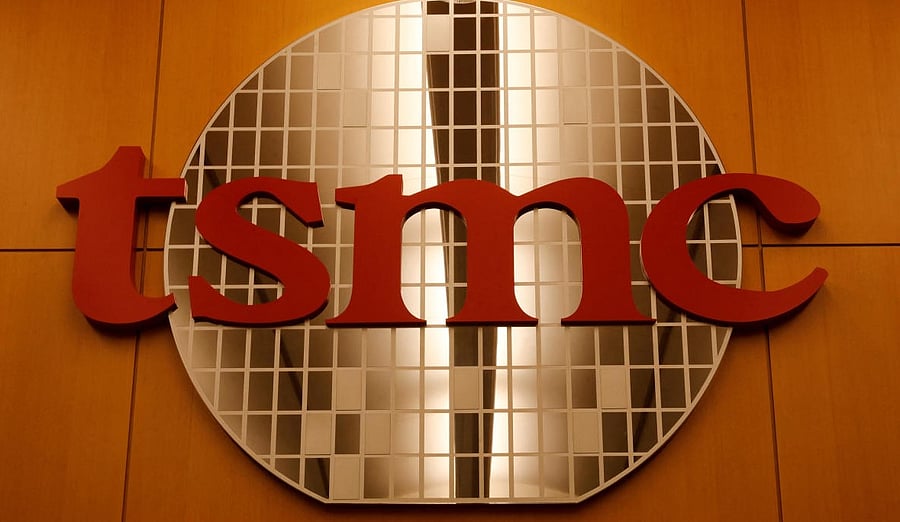
A logo of Taiwan Semiconductor Manufacturing Co (TSMC) is seen at its headquarters in Hsinchu.
Credit: REUTERS FILE PHOTO
Today’s national security problems and contests for power are increasingly tied to technological advancements, or more precisely, access to technologies. The ongoing power rivalry between the US and China is centred on access to high-end semiconductor chips and involves a slew of export control measures that aim to restrict the flow of this advanced technology to China. Interestingly, though, a key segment of the chip supply chain -- the fabrication business -- is dominated not by the US but by Taiwanese chipmakers, especially Taiwan Semiconductor Manufacturing Company (TSMC). Taiwan accounts for 92% of the global production of advanced chips, and over 90% of semiconductors used by China are either imported or produced by foreign companies. This is also linked to Taiwan’s longstanding security conundrum – the threat of Chinese invasion.
The critical nature of Taiwan’s chip industry, and China’s inability to replicate it, only increases the attractiveness of the island to Beijing. The reliance of both the US and China on Taiwan acts as what Taipei calls its ‘Silicon Shield’. The proponents of this theory believe that America’s reliance on Taiwan for advanced semiconductors makes it more likely that the US will militarily defend Taiwan against a Chinese invasion. Recent Chinese military drills around Taiwan in the aftermath of its new President’s inauguration are yet another sign of Beijing’s determination to achieve reunification with Taiwan. The emerging situation begs reconsideration of the ‘Silicon Shield’ theory: Will chips prevent an invasion of Taiwan or make it more likely?
This is also significant in light of the rapidly transforming global chip landscape. As a response to US export controls and diplomatic pressure, the Taiwanese chip and contract manufacturing business is starting to retreat from mainland China. This is complemented by Taiwan’s new policy that aims to diversify its economic engagement away from China. TSMC’s recently set-up advanced chip fabrication facility in Arizona also indicates greater integration with the US chip ecosystem. Then there’s America’s increasing interest in the horizontal diversification of the chip supply chain toward emerging economies like India and Vietnam. It is thus necessary to review the importance of the TSMC factor in China’s calculus for an invasion.
There are three reasons why the TSMC factor should not be a primary consideration behind a Chinese invasion: First, if TSMC were to fall under Chinese control, it is expected that the company would forfeit a substantial portion (two-thirds of its revenue) of its American business, having significant implications for TSMC’s dominant position in the global chip market. An added dimension regarding control of assets was recently stated by ASML. The Dutch equipment supplier said it could remotely disable the Extreme Ultraviolet (EUV) machines it supplies to TSMC
with a ‘kill button’ if China invades Taiwan.
Secondly, Taiwan’s growing interest in expanding overseas, most prominently visible in TSMC’s Arizona fab, makes dynamics between the US, China and Taiwan look more precarious. As the company diversifies its production and client base away from mainland China to the US, the prospect of a successful Chinese take-over of Taiwan’s chip ecosystem becomes improbable. However, it can also be argued that the latest attempts at onshoring chip fabs in the US signal America’s Taiwan-plus approach and signals a disinterest in Taiwan’s own safety, thereby reducing deterrence against a Chinese invasion plan.
Thirdly, it is crucial to recognise that gaining control over Taiwan will not necessarily translate into control over its semiconductor industry. Taiwan’s chipmakers are heavily reliant on American design software, intellectual property, and customers like Nvidia and Apple. Even if China could initially keep operations going at Taiwan’s fabs following an invasion, keeping the chip-building equipment going for long without support from US and
European vendors would likely prove impossible.
A future security scenario across the Taiwan Strait also depends on China’s own ongoing indigenisation drive in its semiconductor industry. China has launched a massive indigenisation drive aimed at building a domestic chip industry, with plans to invest over $150 billion in semiconductors by 2030. However, so far, the results have been mixed, at best. Though China has had success in producing lagging-edge chips, its efforts to build a self-sufficient ecosystem have not been effective, including due to bureaucratic corruption and corporate failures within.
Of course, despite the US sanctions and other factors, the Chinese chip industry continues to make headlines on purported breakthroughs. However, such developments seem to only underscore China’s continued reliance on foreign suppliers in the United States and its allies. And since it is unlikely that China will match the sophistication of industry leaders anytime soon, Taiwan is ever more important for Beijing to meet its technological ambitions.
(The writer is a Dr TMA Pai Fellow and a Doctoral Candidate at the Dept. of Geopolitics and International Relations, Manipal Academy of Higher Education)